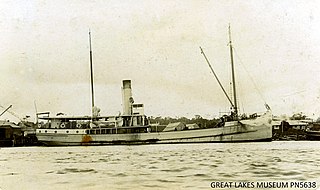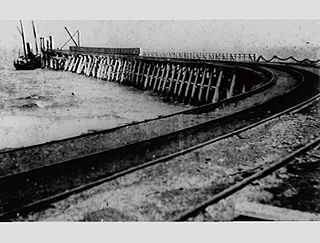
SS Elingamite was an Australian passenger steamer of 2,585 tons, built in 1887, and owned by Huddart Parker. The ship was wrecked on 9 November 1902 off the north coast of New Zealand carrying a large consignment of gold. Now the Elingamite wreck is a favourite site for adventurous divers because of the drama associated with it, and wild tales of lost treasure.

Marlborough was an iron-built two-decked merchant sailing ship which disappeared in 1890. She was built by the firm of Robert Duncan and Co., Port Glasgow and launched in 1876 for her owner John Leslie, who later sold her to the Albion Line. Marlborough disappeared during a voyage in January 1890, and has not been seen or heard from in over a century. Searches and investigations have yielded nothing conclusive, and the ship's ultimate fate, and that of her crew, remains unknown.
Ada and Ethel was a wooden schooner that was wrecked 10 miles (16 km) southeast of Seal Rocks, New South Wales, Australia, on 26 October 1887.

SS Myron was a wooden steamship built in 1888. She spent her 31-year career as lumber hooker, towing schooner barges on the Great Lakes. She sank in 1919, in a Lake Superior November gale. All of her 17 crew members were killed but her captain survived. He was found drifting on wreckage near Ile Parisienne. Her tow, the Miztec, survived. Myron defied the adage that Lake Superior "seldom gives up her dead" when all 17 crewmembers were found frozen to death wearing their life jackets. Local residents chopped eight of Myron's sailors from the ice on the shore of Whitefish Bay and buried them at the Mission Hill Cemetery in Bay Mills Township, Michigan.
The Advance was a wooden topsail schooner built in 1872 at Terrigal, that was wrecked when it missed stays whilst carrying ballast between Botany Bay and Port Stephens under the command of Captain J. Delaney and was lost at Henry Head Bight, Botany Bay, New South Wales on 11 February 1884

The Comboyne was a wooden screw steamer built in 1911 at Tuncurry, that was wrecked when it struck an object whilst carrying timber to Wollongong and was lost at approximately 1 mile (1.6 km) off Bass Point, Shellharbour, New South Wales on 27 November 1920.

The Alhambra was an iron steamer screw built in 1853 by Samuda Brothers at Cubitt Town, London. It was wrecked in a collision off Newcastle, near Nobbys Head, New South Wales, on 30 June 1888.

The Narara was a wooden carvel screw steamer built in 1900 at Jervis Bay, that was wrecked when it sprang a leak while carrying general cargo between Sydney and the Hawkesbury River and was lost at 2 ml SE off Little Reef Newport near, Barranjoey, New South Wales on 29 May 1909. The vessel commenced her runs from Sydney Harbour to the Hawkesbury River in January 1900 and continued on this run till the time of her final 1909 sinking. During 1903 the vessel was burned to the water line and sank at its mooring only to be refloated and rebuilt and started back on the same run.

The Koonya was a wood carvel screw steamer built in 1887 at Hobart, that was wrecked when it stuck the shore at Doboy reef whilst carrying passengers & cargo between Moruya and Sydney and was lost off Cronulla Beach, Port Hacking, New South Wales on 25 January 1898.

Koraaga was a Castle class steel-hulled trawler built in 1914 by Smith's Dock Company, South Bank, Middlesbrough. She was requisitioned as an auxiliary minesweeper operated by the Royal Australian Navy (RAN) in October 1917 for minesweeping duties during World War I, but she was never commissioned. Koraaga returned to be operated commercially as a fishing trawler until she wrecked when she struck a reef off Bass Point whilst carrying returning to Sydney. She was refloated on the tide after having becoming stranded and drifted till she was finally lost 5 miles east of Black Head, Gerringong on 10 September 1931.

The Merksworth was an iron steamer screw built in 1874 at, Paisley, that was wrecked when it swamped whilst carrying coal between Newcastle and Sydney and was lost off Newcastle, Stockton Beach, New South Wales on 7 May 1898.
Wandra was a wooden twin screw steamer built in 1907, for Allen Taylor & Company, by Denis Sullivan at Coopernook, New South Wales. Her hull was towed to Sydney for her engines to be fitted by Begg and Greig.

The Nimbin was a steel screw steamer built in 1927 at Copenhagen, that was the first motor vessel placed into the New South Wales coastal trade. It was owned and operated by the North Coast Steam Navigation Company and was the first Australian registered merchant ship to be lost during World War II when it struck a mine laid by the German auxiliary cruiser Pinguin. The Nimbin was on its way from Coffs Harbour to its home port, Sydney, with a cargo of bundled three-ply timber and a cargo of pigs. One third of the ship was blown away and it sank in three minutes. Seven men were killed. The remaining thirteen clung to bundles of plywood. Some hours later an air force plane from RAAF Base Rathmines saw the survivors and directed the coastal ship SS Bonalbo to the scene to retrieve them.

Colonist was a general cargo and passenger schooner built in 1861 at Dumbarton Scotland by Denny & Rankine. It spent nearly 30 years plying the Western Pacific-based out of Sydney. It wrecked and later re-floated on the remote Elizabeth Reef 550 km from New South Wales, as well as being involved in the gold rushes. Its master was murdered before it was finally involved in a collision in Sydney Harbour, in which it was sunk.

The Herald was an iron paddle steamer imported as frames from the United Kingdom and assembled in 1855 by Richard Johnson in Sydney Harbour, New South Wales, Australia, where she was registered. The Herald is one of the earliest iron paddle wheel steamers built in Australia, where she operated within Sydney Harbour. She was initially used on the fledgling North Shore route between Dawes Point and Blues Point by the newly formed North Shore Steam Company; however, due to not enough traffic to make her financially viable, she often performed tug duties. Eventually the North Shore Steam Company was wound up; the vessel was put up for sale but continued picking up business wherever it was available, operating as a tug, ferry, excursion boat and cargo vessel.
SS Kate was a wooden carvel screw steamer built in 1883 at Balmain that was twice struck and sunk by Port Jackson & Manly Steamship Company ferries.

The Lyman D. Foster was an ocean-going, cargo-carrying, wooden sailing vessel named after the son of a provisions merchant who invested in vessels. Built at the Hall Brother's shipyard at Port Blakely, Washington (state), U.S.A. in 1892, she was 184 feet long with a 39-feet beam and 15.4 feet depth, and 778 tons in weight.

The Amboy was a wooden schooner barge that sank along with her towing steamer, the George Spencer on Lake Superior off the coast of Schroeder, Cook County, Minnesota in the United States. In 1994 the remains of the Amboy were added to the National Register of Historic Places.

Sixty-miler (60-miler) is the colloquial name for the ships that were used in the coastal coal trade of New South Wales, Australia. The sixty-milers delivered coal to Sydney Harbour from ports and ocean jetties to the north and south of Sydney. The name refers to the approximate distance by sea from the Hunter River to Sydney.
















